How To Paint Light Reflection On Water

Always Wanted To Acquire How To Paint Water Realistically?
My process teaches y'all how to paint water, and really see water, in a whole new style.
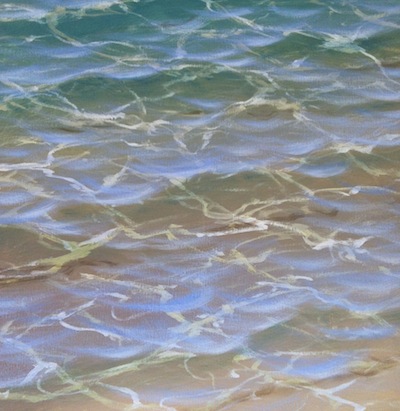
Water is one of the well-nigh compelling subjects to paint, and even so information technology can all cease so badly. The problem often is; where to outset?
I wrestled with creating the illusion of fluidity, clarity and some semblance of realism for a long time.
Eventually I discovered a way of looking at water that allows us to recreate information technology in almost any circumstance.
The play tricks is to break it downward into manageable pieces, rather than try and pigment information technology in its entirety. When you sympathize how these pieces touch each other, learning how to paint water becomes much easier. Y'all will detect that you may wait at h2o in an entirely different way.
Before we kickoff, still, there are a couple of things I need to say. When painting something realistically there are ii overriding skills needed, and particularly when learning to paint water:
- Firstly, your technical ability, or your ability to employ a castor, mix color etc.
- Secondly, your ability to observe, and detect the item necessary to create something that is convincing.
This tutorial is primarily about the "details" I utilise when painting h2o.
The next point is that this strategy is non the just style, nor perhaps the best way. But information technology works brilliantly for me, and hopefully will for you, as y'all larn how to represent water in your paintings.
At present that's out of the style, allow's go into it!
When learning to paint water realistically, it is important to consider that the advent of water is made up of four elements:
- The substrate (or bottom. No, not bottoms. This is how to paint water - non how to paint figures).
- The colour of the water (determined by what is suspended in it)
- The surface of the water
- The lightAt present we'll look at each of them in a little more detail:
| The Substrate |
|---|
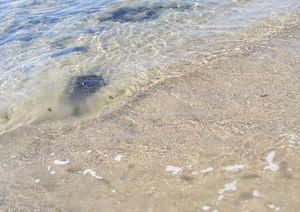
The substrate could be made up of shell, gravel, coral, river stones; or if you live in a major city, motorcar bodies and small calibre pistols.
Whatever the substrate, depending on the other elements, you volition be seeing a lot of it, or not much. Next trip to the beach, lake or swamp, check out how much of the substrate you lot can see.
| The Colour of The H2o |
|---|
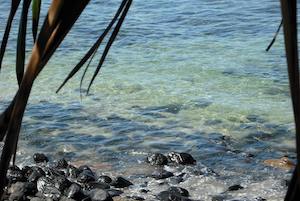
This is determined by the sediment it is carrying. Later rain, chances are that the water in your local river will be tainted with sediment. Later a lot of rain, sometimes there is so much sediment that seeing the lesser is almost impossible (unless the water is very shallow).
Apparently, not much sediment and clean water will minimise the impact that the colour of the water has on the substrate.
A lovely example is a lake in my area that is stained with a tannin from the trees around it.
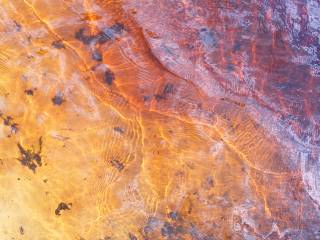
It has a fantastic blood-red tinge to it, and is as dark as cola (arguably better for you than cola, despite the number of small children that swim in it). When yous expect at the water in this lake it is very like shooting fish in a barrel to see how thecolour of the h2o impacts the colour of the substrate.
| The Surface of The H2o |
|---|
This is probably the most important element of all when learning how to paint water. The surface of the water is afflicted by many different things, ripples caused by wind, children splashing, boats, etc. Y'all get the picture. The interesting thing about the surface of the water, is that it impacts the appearance of water in two ways:
- Refraction, and
- Reflection
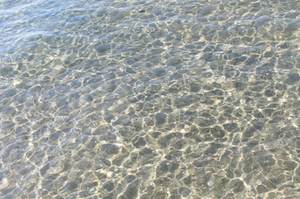
Refraction
When h2o moves, it concentrates and dissipates light. Each wave, whether small or big, volition class a lens. Light will be full-bodied - forming that wonderful pattern that is thrown on the bottom of a puddle simply after everyone has got out.
This issue occurs to varying degrees depending on how rough or smooth the surface is, and the forcefulness of the light. Less calorie-free = less refraction. More light = more refraction.
Nosotros'll go into some painting techniques to create this effect a little afterwards.
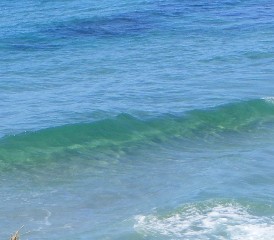
Reflection
Each time awave rises, big or small, information technology reflects light. Any is behind the wave (relative to you lot) needs to exist represented - regardless of the substrate, and regardless of the colour of the h2o.
A sunlit blue sky will show a sunlit blueish reflection. A beautiful sunset volition reverberate the beautiful sunset. That's all fairly obvious, but........ you may non have considered thateach time a wave forms, its confront creates a window. This allows you to see under the surface (if the water is relatively clear).
Think of theface of the wave towards you lot as a window to nether the surface. Think of everything else equally a reflection of the light.Windows and mirrors.
I've probably made all this sound more complicated than information technology is but I promise to show youeasy ways of representing and painting the elements.
| The Calorie-free |
|---|
Thankfully we have just covered it. The light we see on the water is directly impacted by the surface. Read above Refraction and Reflection sections once again for a refresher on light.
An Exercise!
Here is a painting do to help us understand how water appears, and assistance you along in your painting journey.
TIP: H ave a few bare canvases effectually to test things on. I will often paint an aspect of a painting on a separate sail, so I know what I am doing before I commit it to a "serious" piece.
Prepare a small canvas and imagine that we are painting a sandy bottom (Again? Actually. How old are you lot people? You lot know I meant substrate - this is painting water call up!) in shallow clear water on a sunny mean solar day. I employ Artists quality acrylic paints by Chroma Commonwealth of australia, Atelier Interactive and Atelier Free Flow.
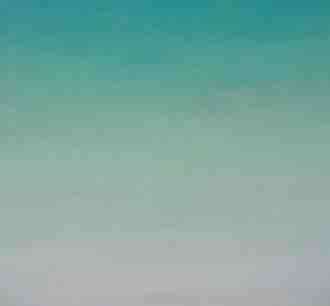
Now we desire to correspond each of the elements. We demand to practise this efficiently. Nosotros could merely paint the substrate. It can be deadening to add layers of thin glazes to represent the color of the water. Nosotros want to make the process of learning to paint h2o as unproblematic as possible. It is much easier to paint the substrate (sand for example) and create the illusion of differing depths with a gradation of color.
Preparing the canvas to this point will train yous in a very of import skill. Painting a controlled gradation of colour/s is something many achieved artists struggle with. Employ a largish brush (ie size eight or 10) and plenty of pigment.
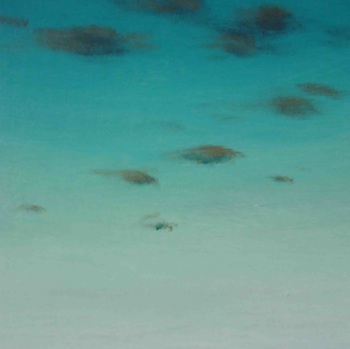
The next part of this process is to represent the refraction of light on the substrate. This is not an like shooting fish in a barrel affair, however a technique I have developed makes information technology easier. You need to allow your brush to be controlled in an uncontrolled way. What the? It volition make sense! Promise!
Find a spare canvas to practice this skill. Grab a small chisel brush size 4 or 6 and load it with paint. Make this pattern - you volition demand to roll your castor between your fingers whilst pushing it backwards and forwards horizontally, creating extremely loose & wobbly diamond shapes. Allow the brush to make its own way, to a certain extent.
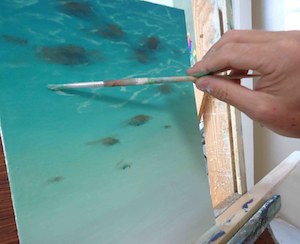
This represents the low-cal which is refracted by the surface of the water, down onto the substrate. Exist enlightened that if you wish to create the illusion of altitude then you must adjust the size of the "openings" as they recede into the distance. Important - you need to be aware, when applying this technique to a "proper" painting, the refraction will alter colour as it goes into deeper water.
When you have experimented with this and feel comfy with the results, you tin can so apply this to your exercise. Hopefully you should take painted something like this.
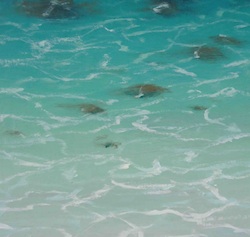
Now for the surface and the light. Thankfully, in this how to paint water exercise, this is relatively easy - both elements can be painted using one technique.
When using acrylics, the next part is easier if your previous work is dry. Brand sure you accept a very dry out brush (size 6 or viii) with the tiniest amount of pigment and make a serial of very shallow W's. These W's represent small waves and are where the lite coming from behind the moving ridge is reflected to your eye.
They seem to sit above the substrate creating the illusion of depth.
Do non paint them neatly and in rows. They volition look like a backdrop for a pantomime. They should look something like this.
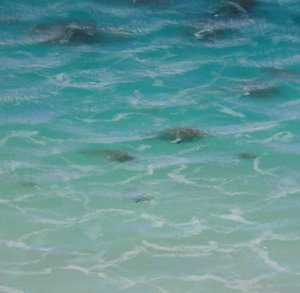
That'southward it! You take represented all of the four elements.
Whoa, hold on there. You may accept noticed that the real world does not always wait similar your practice. Aye, its truthful. It doesn't. This is where you get homework. Go out into the world and find each of these elements. Identify each one dissever from the others. Identify the shapes and colours associated with each chemical element.
Then, beginning looking at each of the elements and notice how much of the substrate is visible because of the colour of the water. Await at how much is visible because of the surface of the water and by default, the light. Spend some time noticing how much each of the elements affects the others in the morning, at sunset - and at other times of the day.
Build your observational skills and watch your paintings improve. Having only 4 elements to work with, gives yous a good solid base of operations to start.
If you find yourself stuck and want some visual assistance, I become into it in much more particular in my DVD:

H2o Fundamentals.
My iii-pack of DVDs is now available in hard re-create and downloadable format - click hither for more than info on my 3-pack (cheaper than buying them one at a time!).
Happy painting!
Learning how to pigment h2o can (and should) be fun!
Dig in, its a contact sport.
For more tips, special offers and inappropriate humour, please subscribe to our monthly e-zine,Acrylics Anonymous.
Subscribe Here:
Top of How to Paint H2o
Dorsum To Painting Tutorials
Dorsum to Explore Acrylic Painting Home Page

Source: https://www.explore-acrylic-painting.com/how-to-paint-water.html
Posted by: barnettankining.blogspot.com

0 Response to "How To Paint Light Reflection On Water"
Post a Comment